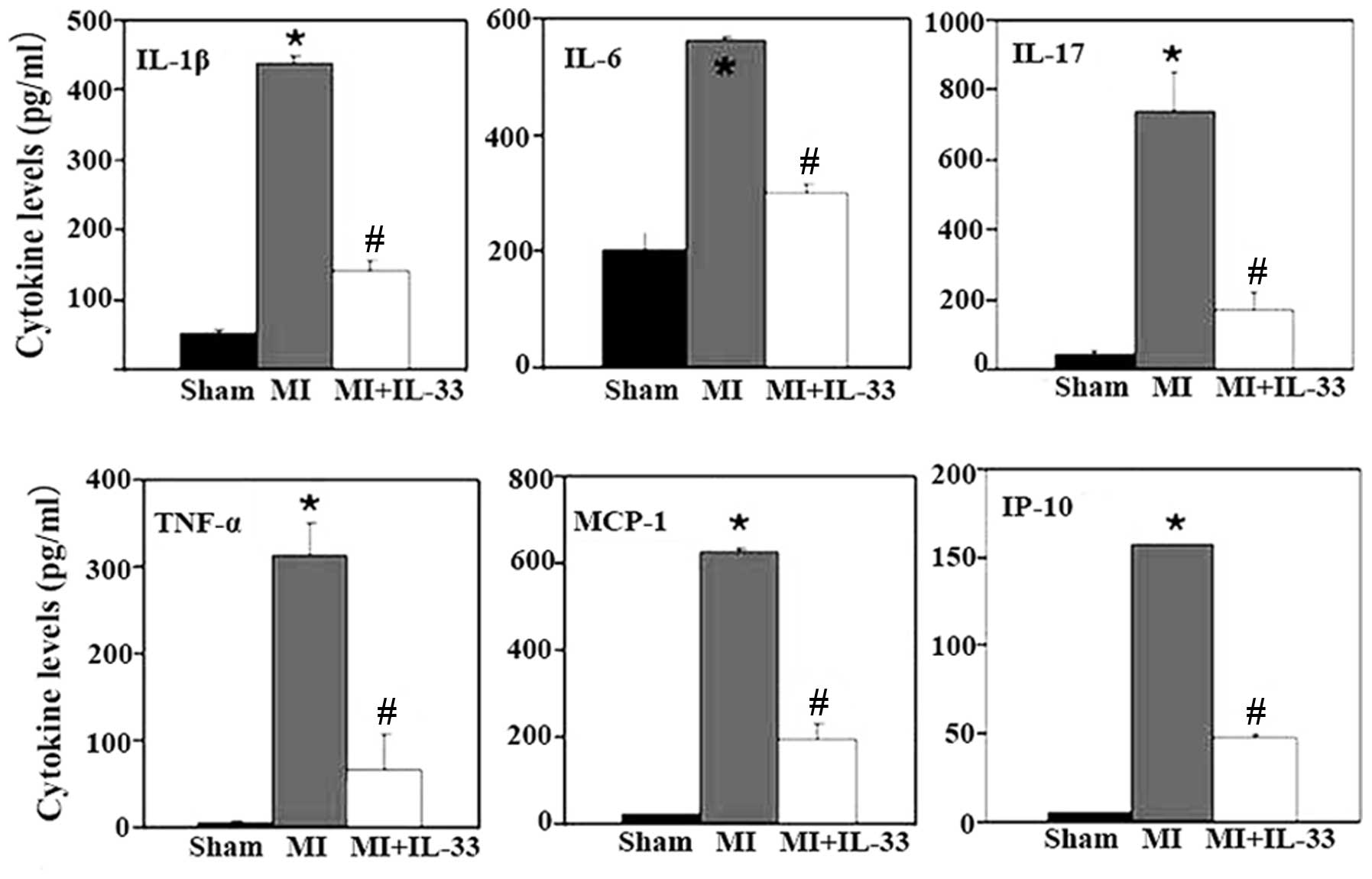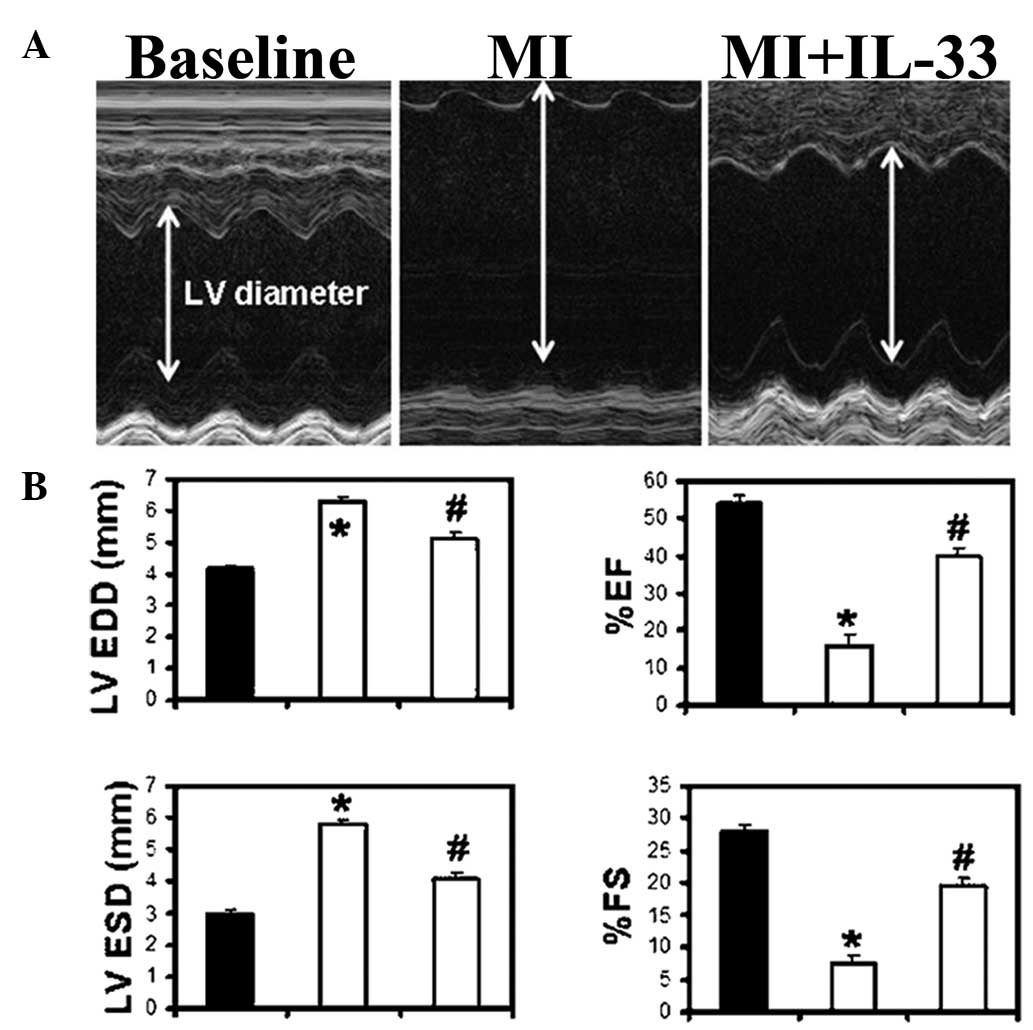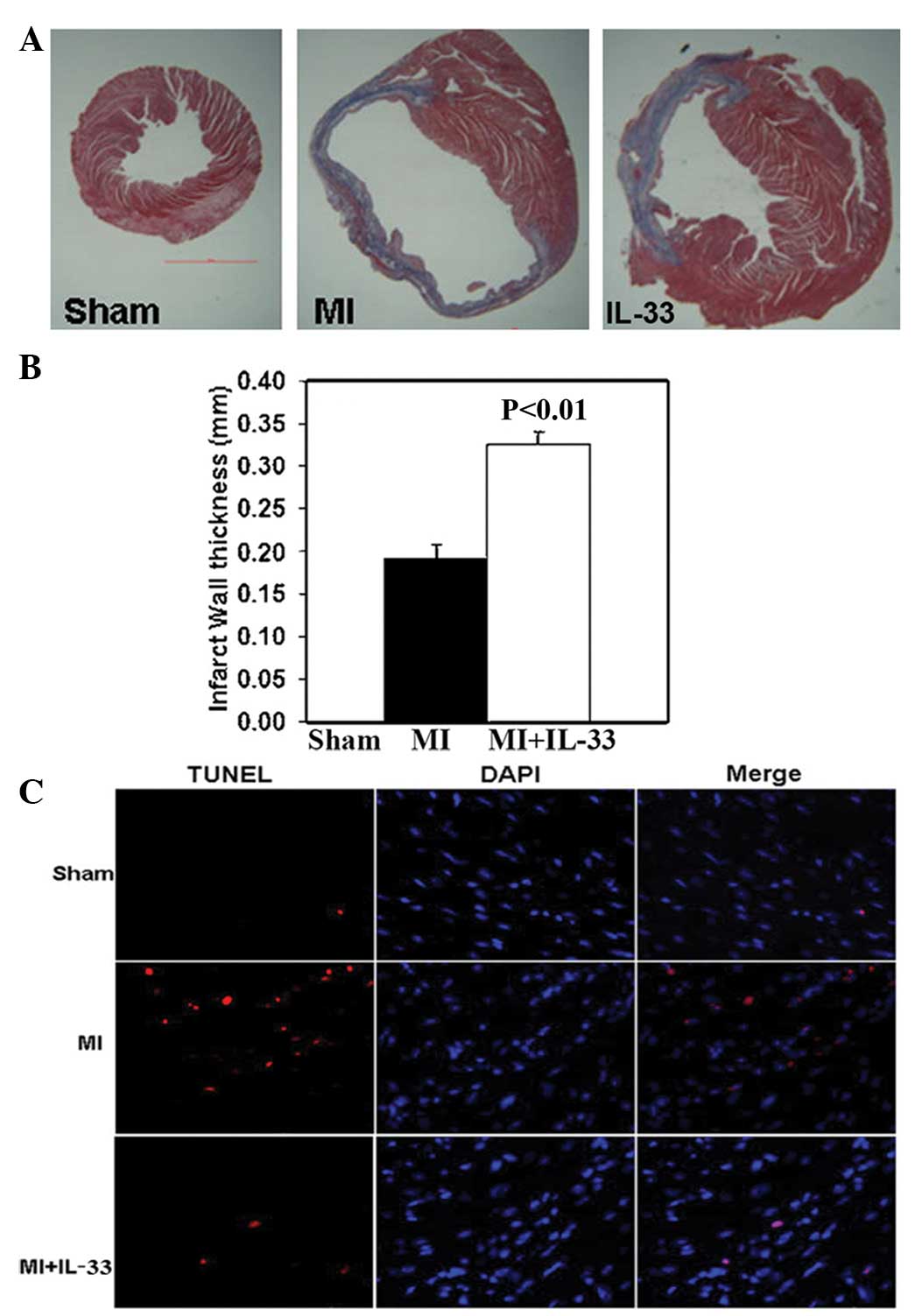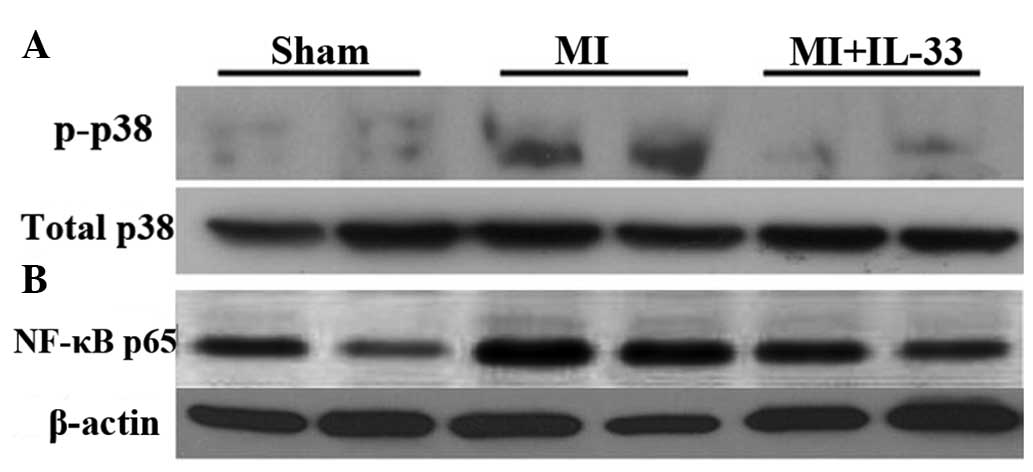IL-33 attenuates cardiac remodeling following myocardial infarction via inhibition of the p38 MAPK and NF-κB pathways
Retraction in: /10.3892/mmr.2022.12868
- Authors:
- Published online on: March 14, 2014 https://doi.org/10.3892/mmr.2014.2051
- Pages: 1834-1838
Abstract
Introduction
Cardiovascular disease is one of the leading causes of mortality worldwide (1). Heart failure resulting from various cardiovascular diseases remains a leading cause of morbidity and mortality worldwide (2). Despite numerous therapeutic strategies for heart failure, further studies examining the underlying molecular mechanisms are required in order to develop more efficient drugs (3).
Myocardial infarction (MI) and ischemia reperfusion injury leading to heart failure are closely linked to inflammatory responses (4,5). The excessive expression of pro-inflammatory cytokines, including tumor necrosis factor-α (TNF-α), interleukin-1 (IL-1) and IL-6 may lead to adverse effects in the heart (6,7). Accumulating evidence has demonstrated that p38 mitogen-activated protein kinase (p38 MAPK) and nuclear factor-κB (NF-κB) activation are involved in myocardial damage and adverse cardiac remodeling (8,9).
As a member of the IL-1 family, IL-33, unlike other members, including IL-1β and IL-18, predominantly induces Th2-skewed responses (10,11). Notably, depending on the actual context, IL-33 may have either pro-inflammatory or anti-inflammatory properties (12). Of note, IL-33 has a protective effect in atherosclerosis (13). However, the therapeutic effect of IL-33 on left ventricular (LV) dysfunction and remodeling following MI remains unclear. Thus, the present study aimed to elucidate the role of IL-33 in LV dysfunction and remodeling post MI.
Materials and methods
Animals and reagents
All experiments were approved by the Institutional Animal Ethics Committee of the First Affiliated Hospital of Xinxiang Medical University (Xinxiang, China) and the study was approved by the Ethics Committee of The First Affiliated Hospital of Xinxiang Medical University. The study was approved by the ethics committee of the First Affiliated Hospital of Xinxiang Medical University, Xinxiang, China.. C57BL/6, 10-week old mice were procured from the Xinxiang Medical University Animal Laboratory (Xinxiang, Henan, China).
Antibodies against NF-κB p65, p-p38 and total p38 were purchased from Cell Signaling Technology (Boston, MA, USA). β-actin was purchased from Santa Cruz Biotechnology, Inc. (Santa Cruz, CA, USA). The recombinant mouse IL-33 was obtained from R&D Systems (Minneapolis, MN, USA).
MI induction and treatments
Mice MI was induced by ligation of the left anterior descending coronary artery (LAD) (14). The mice were injected intraperitoneally with recombinant mouse IL-33 (1 μg; MI + IL-33 group) or saline (MI group) on 0, 1, 2, 3, 4, 5, 6 and 7 days post-MI. The administration of IL-33 was based on a previous study (13). The sham group underwent the same procedure with the exception of LAD ligation and received intraperitoneal saline. Inflammatory indicators were detected on day 3, LV functions on days 14 and 28 and structural remodeling on day 28 post-MI (15).
Echocardiography
The recording of the transthoracic 2D M-mode echocardiogram was obtained using a Toshiba Aplio 80 imaging system (Tochigi, Japan) equipped with a 12 MHz linear transducer. Echocardiography was performed at baseline and at 14 and 28 days post-MI under anesthetization. M-mode tracings were used to measure LV wall thickness, left ventricular end-systolic diameter (LVESD) and left ventricular end-diastolic diameter (LVEDD). The percentage of fractional shortening (FS) and ejection fraction (EF) were calculated as reported (16). All echocardiographic assessments were performed by the same investigator.
Morphology
The hearts were fixed with 10% buffered formalin and embedded in paraffin. Examination of the morphology, including infarct size and wall thickness, was performed on Masson’s trichrome staining. Wall thickness was measured perpendicular to the infarcted wall at three separate regions and averaged.
Terminal deoxynucleotidyl transferase mediated dUTP nick end-labeling (TUNEL) staining
TUNEL staining was conducted on 4 μm thick paraffin-embedded sections according to the manufacturer’s instructions (cell death detection assay; Roche Diagnostics, Mannheim, Germany). DAPI staining was used to count the total number of nuclei.
Assessment of cytokine levels
Six mice from each group were euthanized 3 days following surgery. The levels of TNF-α, IL-1β, IL-6, IL-17, interferon inducible protein-10 (IP-10) and monocyte chemotactic protein-1 (MCP-1) were quantified in the border zone of the infarct as described previously with specific ELISA kits (R&D Systems) according to the manufacturer’s instructions.
Immunofluorescent staining of macrophages
Immunofluorescent staining for tissue sections was performed as previously described (17). The hearts of mice were harvested following surgery and frozen. Non-specific protein binding was inhibited with 10% normal horse serum. The sections were incubated with rabbit anti-F4/80 antibody (1:50; Abcam, Cambridge, MA, USA) at 4°C overnight, followed by Cy3-goat anti-rabbit IgG as a secondary antibody for 30 min. The normal rabbit IgG served as the negative controls. Images were examined with a fluorescent microscope (Nikon, Tokyo, Japan).
Western blot analysis
Tissue lysates were prepared from the LV infarct border zone. Total or nuclear proteins from tissues were extracted using extraction kits (Millipore, Billerica, MA, USA). Proteins (40 μg) were electrophoresed and analyzed using corresponding primary antibodies as indicated above. The protein was verified using antibodies against β-actin.
Statistical analysis
Data are presented as the mean ± SEM and analyzed using the Student’s t-test or one-way analysis of variance test. P<0.05 was considered to indicate a statistically significant difference.
Results
IL-33 treatment inhibits inflammation in the myocardium post-MI
IL-33 treatment resulted in significantly reduced levels of multiple pro-inflammatory cytokines and chemokines, including IL-1β, IL-6, IL-17, TNF-α, MCP-1 and IP-10 (Fig. 1). Furthermore, immunofluorescent staining of macrophages was performed, as indicated by F4/80+ cells, on cardiac tissue sections. Infiltration of F4/80+ cells in the border zone of the LV infarct was significantly increased 3 days post-MI (P<0.01 vs. sham; Fig. 2). IL-33 treatment significantly inhibited F4/80+ cell infiltration at the injured sites (P<0.01 vs. MI group; Fig. 2).
IL-33 treatment attenuates LV dysfunction post-MI
LV function was determined by M-mode echocardiography 14 and 28 days post-MI. The MI group demonstrated increased LVESD and LVEDD (P<0.01 vs. baseline; Fig. 3A and B; Table I) and a decreased percentage of FS and EF at 28 days post-MI (P<0.05 vs. baseline; Fig. 3B; Table I). IL-33 treatment attenuated heart dysfunction by significantly lowering LVESD and LVEDD and increasing the percentage of FS and EF in comparison with the MI group (P<0.05 versus the MI group; Fig. 3B). The heart rates were comparable between the groups. The changes in LV function were also observed at 14 days in a trend similar to that 28 days post-MI (Table I).
IL-33 treatment inhibits infarct size and infarct wall thinning
The infarct size was measured as the percentage of the LV circumference based on trichrome staining 28 days post-MI. The infarct size was significantly reduced in the IL-33 treated group versus that in the MI group (30.82±1.25 vs. 43.14±0.67%; P<0.01; Fig. 4A). Additionally, IL-33 treatment increased the infarct wall thickness compared with a thin wall in the MI group (0.34±0.02 vs. 0.19±0.02 mm; P<0.01; Fig. 4B).
IL-33 inhibits MI-induced cardiac cell apoptosis
The TUNEL method was used to detect cardiac apoptosis 3 and 28 days post-MI. Similar trends were observed at the two time points following MI. MI increased the number of apoptotic cells in the border zone of infarction compared with the sham group (apoptosis: 3.07±0.24 vs. 0.32±0.01%; P<0.01; Fig. 4C). IL-33 administration significantly reduced the number of apoptotic cells in the border zone of the LV infarct (apoptosis; MI + IL-33; 1.83±0.28%; P<0.01 vs. MI; Fig. 4C).
IL-33 suppresses p38 MAPK phosphorylation and NF-κB activation post-MI
Western blot analysis demonstrated that phosphorylation (activation) of p38 MAPK (p-p38) was upregulated in the myocardium 3 days post-MI (P<0.01 vs. sham; Fig. 5A). IL-33 treatment significantly reduced the phosphorylation of p38 MAPK (P<0.01 vs. MI; Fig. 5B). As expected, nuclear NF-κB p65 protein expression was significantly upregulated following 3 days of MI (P<0.01 vs. sham; Fig. 5B), which was suppressed by IL-33 treatment (P<0.01; Fig. 5B).
Discussion
Cardiac events, including reperfusion injury and cardiac remodeling, have been associated with the activation of pro-inflammatory cytokines, including TNF-α, IL-1β and IL-6 (18). In the present study, IL-33 limited the inflammatory response in the mouse MI at 3 days and improved the LV function and remodeling at 28 days post-MI. The above effects were at least partly due to IL-33-mediated suppression of cytokines, p38 MAPK and NF-κB activation.
Inflammation contributes greatly to pathological cardiac remodeling and therapeutic approaches targeting inflammatory cascades have offered promise for heart failure (19). The present study consistently demonstrated that the infiltration of F4/80+ macrophages in the border zone of the myocardium was significantly increased 3 days post-MI. Inflammatory infiltration was accompanied with an increase in various pro-inflammatory cytokines and chemokines (IL-1β, IL-6, IL-17, TNF-α, IP-10 and MCP-1) following MI.
IL-33 treatment reduced atherosclerosis development in ApoE-deficient mice on a high-fat diet (13). The reduction in IL-33 levels increased the sensitivity of the myocardium to ischemia/reperfusion injury (20). In patients with chronic heart failure, IL-33 may exert anti-oxidation effects (21). Consistently, IL-33 treatment inhibited macrophage infiltration and pro-inflammatory mediators in the myocardium. Anti-TNF-α therapy failed to control chronic heart failure in humans, which was partly due to unchanged IL-1β, IL-6 and MCP-1 levels (22). IL-1β antagonism provides cardioprotection against ischemia-reperfusion injury associated with a reduction in apoptosis (23). In the present study, IL-33 was found to inhibit not only TNF-α, but also IL-1β, IL-6, IL-17, IP-10 and MCP-1, which have adverse effects on cardiac remodeling.
p38 MAPK has been demonstrated to mediate the important events in myocardial apoptosis and functional depression via production of TNF, IL-1β and IL-6 following myocardial ischemia (24). The selective inhibition of p38 MAPK exhibited cardioprotective effects in a rat model (25). NF-κB activation in cardiomyocytes contributed greatly to myocardial ischemia/reperfusion damage (26). Inhibiting NF-κB activation reduced cardiac inflammation and apoptosis in a rat model (27). Importantly, our results demonstrated that the administration of IL-33 inhibited p38 MAPK phosphorylation and NF-κB activation. Therefore, in the current study, IL-33 mediated attenuation of LV dysfunction and remodeling may be, at least partly, due to the suppression of the p38 MAPK and NF-κB pathways.
Taken together, our data suggest that IL-33 reduces the pro-inflammatory responses and contributes to improved LV function and remodeling via affecting the activation of multiple cytokines following MI, possibly via the suppression of the p38 MAPK and NF-κB pathways. In addition, understanding the role of IL-33 in the heart may provide novel therapeutic approaches in cardiovascular diseases.
References
|
Binsalamah ZM, Paul A, Prakash S and Shum-Tim D: Nanomedicine in cardiovascular therapy: recent advancements. Expert Rev Cardiovasc Ther. 10:805–815. 2012. View Article : Google Scholar : PubMed/NCBI | |
|
Dhalla NS, Rangi S, Babick AP, Zieroth S and Elimban V: Cardiac remodeling and subcellular defects in heart failure due to myocardial infarction and aging. Heart Fail Rev. 17:671–681. 2012. View Article : Google Scholar : PubMed/NCBI | |
|
Nagai T and Komuro I: Gene and cytokine therapy for heart failure: molecular mechanisms in the improvement of cardiac function. Am J Physiol Heart Circ Physiol. 303:H501–H512. 2012. View Article : Google Scholar : PubMed/NCBI | |
|
Timmers L, Sluijter JP, van Keulen JK, et al: Toll-like receptor 4 mediates maladaptive left ventricular remodeling and impairs cardiac function after myocardial infarction. Circ Res. 102:257–264. 2008. View Article : Google Scholar : PubMed/NCBI | |
|
Tao ZY, Cavasin MA, Yang F, Liu YH and Yang XP: Temporal changes in matrix metalloproteinase expression and inflammatory response associated with cardiac rupture after myocardial infarction in mice. Life Sci. 74:1561–1572. 2004. View Article : Google Scholar | |
|
de Faire U and Frostegård J: Natural antibodies against phosphorylcholine in cardiovascular disease. Ann NY Acad Sci. 1173:292–300. 2009.PubMed/NCBI | |
|
Sun M, Dawood F, Wen WH, et al: Excessive tumor necrosis factor activation after infarction contributes to susceptibility of myocardial rupture and left ventricular dysfunction. Circulation. 110:3221–3228. 2004. View Article : Google Scholar : PubMed/NCBI | |
|
Turner NA: Therapeutic regulation of cardiac fibroblast function: targeting stress-activated protein kinase pathways. Future Cardiol. 7:673–691. 2011. View Article : Google Scholar : PubMed/NCBI | |
|
Taube A, Schlich R, Sell H, Eckardt K and Eckel J: Inflammation and metabolic dysfunction: links to cardiovascular diseases. Am J Physiol Heart Circ Physiol. 302:H2148–H2165. 2012. View Article : Google Scholar : PubMed/NCBI | |
|
Kunes P, Holubcova Z, Kolackova M and Krejsek J: Interleukin-33, a novel member of the IL-1/IL-18 cytokine family, in cardiology and cardiac surgery. Thorac Cardiovasc Surg. 58:443–449. 2010. View Article : Google Scholar : PubMed/NCBI | |
|
Milovanovic M, Volarevic V, Radosavljevic G, et al: IL-33/ST2 axis in inflammation and immunopathology. Immunol Res. 52:89–99. 2012. View Article : Google Scholar : PubMed/NCBI | |
|
Ohno T, Morita H, Arae K, Matsumoto K and Nakae S: Interleukin-33 in allergy. Allergy. 67:1203–1214. 2012. View Article : Google Scholar | |
|
Miller AM, Xu D, Asquith DL, et al: IL-33 reduces the development of atherosclerosis. J Exp Med. 205:339–346. 2008. View Article : Google Scholar : PubMed/NCBI | |
|
Krishnamurthy P, Subramanian V, Singh M and Singh K: Deficiency of beta1 integrins results in increased myocardial dysfunction after myocardial infarction. Heart. 92:1309–1315. 2006. View Article : Google Scholar : PubMed/NCBI | |
|
Hayashidani S, Tsutsui H, Ikeuchi M, et al: Targeted deletion of MMP-2 attenuates early LV rupture and late remodeling after experimental myocardial infarction. Am J Physiol Heart Circ Physiol. 285:H1229–H1235. 2003.PubMed/NCBI | |
|
Subramanian V, Krishnamurthy P, Singh K and Singh M: Lack of osteopontin improves cardiac function in streptozotocin-induced diabetic mice. Am J Physiol Heart Circ Physiol. 292:H673–H683. 2007. View Article : Google Scholar : PubMed/NCBI | |
|
Ii M, Nishimura H, Iwakura A, et al: Endothelial progenitor cells are rapidly recruited to myocardium and mediate protective effect of ischemic preconditioning via ‘imported’ nitric oxide synthase activity. Circulation. 111:1114–1120. 2005.PubMed/NCBI | |
|
Paulus WJ: Cytokines and heart failure. Heart Fail Monit. 1:50–56. 2000. | |
|
McKinsey TA: Targeting inflammation in heart failure with histone deacetylase inhibitors. Mol Med. 17:434–441. 2011. View Article : Google Scholar : PubMed/NCBI | |
|
Rui T, Zhang J, Xu X, Yao Y, Kao R and Martin CM: Reduction in IL-33 expression exaggerates ischaemia/reperfusion-induced myocardial injury in mice with diabetes mellitus. Cardiovasc Res. 94:370–378. 2012. View Article : Google Scholar : PubMed/NCBI | |
|
Zhang HF, Xie SL, Chen YX, et al: Altered serum levels of IL-33 in patients with advanced systolic chronic heart failure: correlation with oxidative stress. J Transl Med. 10:1202012. View Article : Google Scholar : PubMed/NCBI | |
|
Aukrust P, Yndestad A, Damås JK and Gullestad L: Inflammation and chronic heart failure-potential therapeutic role of intravenous immunoglobulin. Autoimmun Rev. 3:221–227. 2004. View Article : Google Scholar : PubMed/NCBI | |
|
Suzuki K, Murtuza B, Smolenski RT, et al: Overexpression of interleukin-1 receptor antagonist provides cardioprotection against ischemia-reperfusion injury associated with reduction in apoptosis. Circulation. 104:I308–I313. 2001. View Article : Google Scholar | |
|
Wang M, Tsai BM, Turrentine MW, Mahomed Y, Brown JW and Meldrum DR: p38 mitogen activated protein kinase mediates both death signaling and functional depression in the heart. Ann Thorac Surg. 80:2235–2241. 2005. View Article : Google Scholar : PubMed/NCBI | |
|
Li Z, Ma JY, Kerr I, et al: Selective inhibition of p38alpha MAPK improves cardiac function and reduces myocardial apoptosis in rat model of myocardial injury. Am J Physiol Heart Circ Physiol. 291:H1972–H1977. 2006. View Article : Google Scholar : PubMed/NCBI | |
|
Ling H, Gray CB, Zambon AC, et al: Ca2+/Calmodulin-dependent protein kinase II δ mediates myocardial ischemia/reperfusion injury through nuclear factor-κB. Circ Res. 112:935–944. 2013. | |
|
Kim YS, Kim JS, Kwon JS, et al: BAY 11-7082, a nuclear factor-κB inhibitor, reduces inflammation and apoptosis in a rat cardiac ischemia-reperfusion injury model. Int Heart J. 51:348–353. 2010. |














